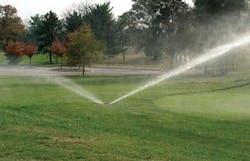Improving Water Efficiencies Down Under
Coal mining operations in Australia require huge quantities of water, extracted from groundwater, rivers and dams, to help prepare products for market. Remote monitoring is essential. A look at why battery powered meters were selected instead of mechanical alternatives in one project.
According to the Australian Government National Water Commission, mining activities in Australia account for 4% of the country's total water consumption. This compares to agriculture (50%), household (12%) and manufacturing (5%). While 4% may seem minute compared to the usage of the agricultural sector, this still equates to 508 gigalitres, the equivalent of 254,000 Olympic swimming pools.
Access to a reliable source of water is an essential requirement for coal mines. Even those mines that do not wash their product through a preparation plant need significant quantities for dust management, drilling, human consumption and numerous other uses. And coal cleaning uses a considerable amount of water. It's cleaned to improve its combustability, which reduces CO2 emissions and to ensure that it is suitable for steel making.
A report from the Australian National University and Department of Sustainability, Environment, Water, Population and Communities highlighted the direct financial consequences of poor operational water management for the coal industry. Running out of water can cost money in lost production: if water is poorly managed, product quality can be compromised. In the long run, if companies do not have a good record of ensuring water quality, then they may not receive approval to open new mines.
Product Highlights• Battery operated, stand alone water meter; Battery life up to 15 years. Manufacturer says excellent performance in low flow conditions and over wide flow range
• Easy installation, no inlet and outlet runs, no filters and bi-directional flow
• Subsoil installation (IP68 + additional protective coating), Installation in chambers is not required)
• Maintenance-free operation, no moving parts, no wear and obstruction free
• Optional, battery powered data logger/GSM module for remote data transfer.
One of Australia's largest exporters of seaborne metallurgical coal operates coal mines in Central Queensland. These mines are supplied by fresh water extracted from borefields, rivers and dams. It owns and operates hundreds of kilometers of pipelines, through which it moves thousands of litres of fresh water per year to its own and competitors' operations and to local mining communities.
The monitoring of water use to support mining operations in remote areas represents a significant challenge to all mineral companies operating in Australia. Often the infrastructure and management systems provided by the company are also used to supply local communities and rural industries. Furthermore, the report highlighted earlier states that a good mine water management system should include a site-specific strategic water plan based on the following goals: maintain salinity level in coal washing to ensure product quality is not compromised (~2500ppm); adopt leading practices for water use productivity (ML/Mt) in coal preparation and underground mining, minimise discharge of used water; maintain coal washing salinity level to ensure flotation benefit (~5000 ppm) and finally that there should be no loss of production due to inability to supply fit-for-purpose water.
It is the latter which presents opportunities to the international water sector. Measurement and balancing of water flows can allow investigation and analysis into water management and substitutions. An essential pre-requisite to gaining better understanding of water consumption is a more comprehensive water flow monitoring network.
Krohne Australia recently supplied 26 WATERFLUX 3070 C battery operated stand-alone water meters to help with this challenge. The electromagnetic meters were chosen to help "provide a reliable solution for the mine site's and communities remote water monitoring needs".
The supplied meter's flow sensor design includes a rectangular cross-section, which the manufacturer says allows for a significant reduction of magnetic field excitation. Coils are arranged so that a strong, homogeneous magnetic field is formed.
This, adds Krohne, ensures the measurement is independent of the flow profile and measurements are very stable. Results include good low flow performance and operation without inlet and outlet runs. An optional data logger and GSM module allows for remote meter reading and wireless transmission of measurement data and status information.
More Water & WasteWater International Current Issue Articles
More Water & WasteWater International Archives Issue Articles

